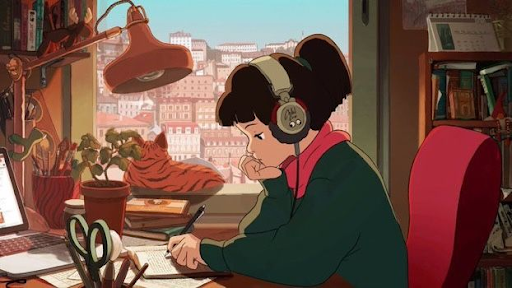Upon first glance, what do you believe this painting is about? For me, the painting depicts a teacher guiding his student while she is trying to play and sing along to a piece of sheet music. Yet, art usually contains more information and is filled with hidden symbols, making the whole painting mean something different than what meets the eye. The viewer has to analyze the artwork and make inferences about the details. Keep in mind that artists usually do not take the time to add details to their painting if it does not affect the viewer.
There are six symbols that seem to convey a different meaning than that of a teacher assisting his student. Think of the saying, “A dog is a man’s best friend.” I have a cat and I can say, I do love her a lot but a dog has a characteristic that cats do not seem to show often: loyalty (cats will cuddle with you one moment and scratch you to death the next). Dogs are known to be loyal to their owners. They overlook all mistakes and mistreatment as soon as you walk in the door after a long day at school or work just to jump on you with kisses and a frantic tail. Dogs in art usually depict loyalty, loyalty in a relationship. Since the dog is sleeping but yet displayed on a chair for the viewer to see, the couple’s relationship is at ease and loyal.
In the winter, one would do anything to stay warm. I have worn three pairs of socks once to go out in the snow since I get cold easily. Perhaps a foot warmer would do better for me especially since Borch’s painting has one in the bottom left-hand corner behind the chair. The vessel would hold coal and, in this case, symbolizes a fire in the relationship. A flame of the heart, one may say.
For cello players, I think we can all say that it is not easy to lug a huge cello everywhere you go. Even bringing the instrument from the car to your house’s entrance can put out your back for a whole week, so why make the effort to lug the instrument if it will not be played? Well in this case, on the table to the left of the painting (although laying on the table), there is a second instrument that would accompany a guitar. Perhaps the word DUET can paint a picture for you (no pun intended). Isn’t it so romantic to not only stand next to the person you love but communicate through the language of music with them? A duet takes two people to compose music that unites them as if they were one.
Now, since we understand the painting has to do with a music lesson of some sort, why is it in the bedroom? The hat on the man represents that he is a visitor, but it is quite strange to not be conducting the lesson in the parlor where there are others around. Doors or windows ajar usually depict fertility and good omens. Along with the setting of the bed in the back with the curtains open, the couple has a good relationship and the possibility of a family is a discussion for the future.
Although viewers have enough symbols to symbolize their whole lives, I am most captivated by the young girl’s ribbon, a blue ribbon to be exact. With an outfit full of white silk and lace along with a red coat trimmed with white fur, blue does not match the outfit. If anything, she could have used another pairing of color, perhaps another shade of red, but blue looks too out of place. Yet, Borch knows the ribbon is right where it is supposed to be; on top of the lady’s head. When you think of a blue ribbon, what comes to mind? After many years of attending the Marshfield Fair, I think of a first prize. When one is recognized as the best of the best, they are awarded a blue ribbon for first place. The young lady is the man’s finest prize and since the ribbon is in her hair, her mind is the greatest prize of all. She is the greatest person for him, and hence the ribbon displays affection.
By now, one can tell I believe the painting is about a romantic relationship but there can be many interpretations. I dare you to look deeper into the details of the painting and try to prove me wrong. I am always open to others interpretations!
By Monica Ronayne ‘25, Staff Writer













